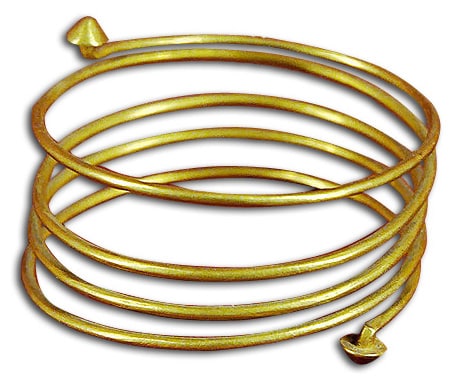The Gold lunula is a distinctive type of early Bronze Age necklace or collar shaped like a crescent moon.
 |
| The gold lunula from the Gwithian area, Cornwall © The Trustees of the British Museum |
They are normally flat and thin, with roundish spatulate terminals that are often twisted to 45 to 90 degrees from the plane of the body.
Of the more than a hundred gold lunulae known from Western Europe, more than eighty are from Ireland; it is possible they were all the work of a handful of expert goldsmiths, though the three groups are presumed to have had different creators. Several examples have a heavily crinkled appearance suggesting that they had been rolled up at some point.
Lunulae were probably replaced as neck ornaments firstly by gold torcs, found from the Irish Middle Bronze Age, and then in the Late Bronze Age by the spectacular gorgets of thin ribbed gold, some with round discs at the side, of which 9 examples survive, 7 in the National Museum of Ireland.
 | ||||
| Gold lunula from Schulenburg, Germany, Provincial, linear group. |
 |
| Gold lunula - British Museum - Found in a bog on the Tir Dewin Farm |
Flat sheet crescent of beaten gold with quadrangular terminals rotated relative to the crescent. It is decorated with an incised geometric pattern.
The horns are decorated with horizontal patterns of horizontal lines, rows of dots, bands of diamond shaped motifs and void spaces. The horn’s inner and outer edges are decorated with a border of horizontal lines.
A band of three incised lines and two irregular rows of dots separate the horns from the rest of the body.
The decoration extends down the body in the form of a border parallel with the inner and outer edges. The border consists of a series of parallel lines and rows of dots.
Gold lunula from Blessington, Ireland, Late Neolithic/Early Bronze Age, c. 2400BC – 2000BC, Classical group
 |
| Chevrons and Lozenges incised into the Blessington Lunula. |
 |
| Llanllyfni, Wales, Britain |















.JPG)